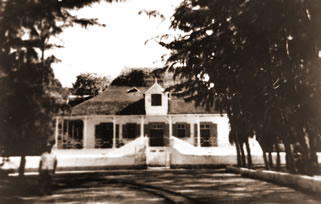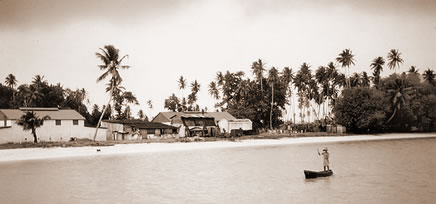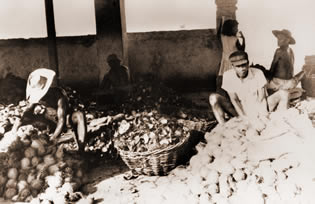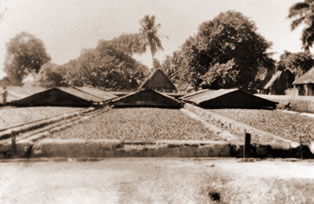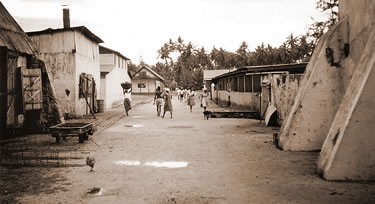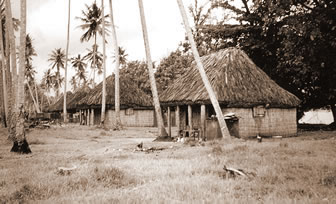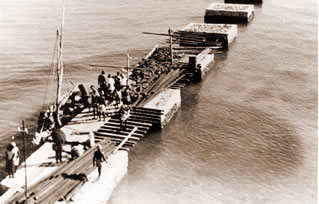Official
Histories of Diego Garcia
Really... These really are Official Histories.
|
History According
to the US Navy
From the NSF Official Web Site, 2006 Diego Garcia was discovered by Portuguese explorers in the early 1500s. It is the largest of fifty-two islands which form the Chagos Archipelago, located in the heart of the Indian Ocean. The island's name is believed to have come from either the ship's captain or the navigator on that early voyage of discovery. A tropical footprint-shaped island just 7 degrees south of the equator, Diego Garcia is heavily vegetated. The island covers 6,720 acres in area with a maximum height of 22 feet and an average elevation of four feet above sea level. The shoreline is about 40 miles long and the island encloses a lagoon 6.5 miles wide and 13 miles long.
In 1965, with the formation of the British Indian Ocean Territory (BIOT), Diego Garcia was under the administrative control of the British government of the Seychelles. In 1976, the Seychelles gained independence from England and the BIOT became a self-administering territory under the East African Desk of the British Foreign Office. The Crown's representative on island, the British Representative (BRITREP), acts as both Justice of the Peace and Commanding Officer of the Royal Naval Party 1002.
Until 1971, Diego Garcia's main source of income was from the profitable copra oil plantation. At one time, copra oil from here and the other "Oil Islands" provided fine machine oil and fuel to light European lamps. During the roughly 170 years of plantation life, coconut harvests on Diego Garcia remained fairly constant, at about four million nuts annually. The plantation years ended with the arrival of the U.S. military construction.
On March 24, 1971 construction began on a U.S. Naval Communication Facility. This construction was accomplished by units of the U.S. Naval Construction Force (Seabees). Naval Communications Station Pre-commissioning Detachment arrived to prepare for operations in December of 1972 and on March 20, 1973 the U.S. Naval Communications Stations, Diego Garcia, was commissioned. The communications facility was later changed to Naval Computer and Telecommunication Station (NCTS) in October of 1991.
A major change to the island organizational structure occurred with the establishment of the Navy Support Facility (NSF) on October 1, 1977. Commanding Officer, NSF, assumed all duties and responsibilities previously assigned to the Island Commander. The nucleus for NSF came from the original Communication Station enlisted and officer allowances. All billets, other than those dedicated to communications support, were transferred to CO, NSF, who is responsible for maintaining and operating facilities and providing services and materials in support of several tenant shore activities and units of the operating forces. Following the overthrow of the Shah of Iran in 1979, Diego Garcia saw the most dramatic build-up of any location since the Vietnam War era. In 1986, Diego Garcia became fully operational with the completion of a $500 million construction program.
The
1990, Iraqi invasion of Kuwait marked the most
intense operational period in Diego Garcia's
history. From 1 August 1990 to 28 February 1991,
NAVSUPPFAC Diego Garcia achieved and maintained
the highest degree of operational readiness and
provided levels of support which outstripped all
contingency planning. As the base population
doubled almost overnight, with the deployment of a
Strategic Air Command Bombardment Wing and other
aviation detachments, workload base-wide increased
from 300-2000% over peacetime levels with no
personnel augmentation. Diego Garcia became the
only U.S. Navy base that launched offensive air
operations during Operation Desert Storm and Diego
Garcia remains a vital link in our defense
structure. 
History According to the US Air
Force The Chagos Islands, of which the largest is Diego Garcia, consist of some 50 small sand cays situated on a large shoal area, the Great Chagos Bank, the whole covering some 22,000 square miles of the Indian Ocean. The islands are remote, with Diego Garcia 1,150 miles from Seychelles and 1,400 miles from Mauritius. It is believed they were first discovered by the great Portuguese navigators of the 18th Century. The islands remained uninhabited until the 18th Century when the French established copra plantations with the aid of slave labor. During the Napoleonic wars, Britain captured Mauritius from the French in 1810 and under the terms of the Treaty of Paris in 1814 Mauritius became a British Colony along with many of the Indian Ocean islands controlled by the French, including the Chagos Islands. When France ceded Mauritius and the other Indian Ocean islands to Britain in 1814, it was decided to retain the arrangement whereby the islands were administered as Lesser Dependencies of Mauritius. Since then there have been several administrative rearrangements, the most notable being the detachment of Seychelles in 1903 to form a separate colony. The position of the Chagos Islands remained unchanged until 1965 when the islands were detached from Mauritius with the full agreement of the Mauritius Council of Ministers to form part of the British Indian Ocean Territory (BIOT). Certain Islands from these were ceded to Seychelles on independence in 1976. In 1966, under a published Exchange of Notes with the US Government, BIOT was made available for the defense purposes of the US and UK in the first instance for 50 years. In the following year the Crown purchased the islands and bought out the plantation owners. The plantations were continued by a company acting as agents for the BIOT Administration on islands required for defense purposes. Therefore there should be no question that the operating company was not aware of the plantations’ uncertain future. After Mauritius became independent in 1968, BIOT was administered from Seychelles until that country’s independence in 1976. The Territory has since been administered from London, under a Commissioner who is a senior official in the Foreign and Commonwealth Office responsible to the Secretary for State and Commonwealth Affairs. The Economy: During the 19th Century, the islands passed into private ownership and copra plantations were established on most of the larger islands. The economy of the islands depended solely on the production of copra and its by-product, coconut oil. The oil was sent to Mauritius where it found a ready market until after the Second World War when it met increasingly keen competition from higher quality vegetable oils imported from elsewhere. The plantations went into a gradual decline, the plantation owners being reluctant or unable to inject fresh capital to modernize production and improve quality. It also proved increasingly difficult to recruit laborers, as the plantation work was monotonous and not well paid, while social amenities on the islands were extremely limited. The remoteness of the islands and the difficulties of communication precluded diversification into other commercial activities. By 1958, the various Mauritius companies exploiting the plantations were heavily in debt and were experiencing difficulty in obtaining further credit. In 1962, they sold out to a Seychelles company that carried on until the plantations closed. The People: The
first plantation workers were slaves brought
mainly from Madagascar of the African
mainland. Following the abolition of the
slave trade and the emancipation of slaves in
Mauritius, legislation was enacted in 1838
requiring contracts of service for workers
throughout Mauritius and its Lesser
Dependencies. Contracts for the plantation
workers ran for a stipulated period and had to be
witnessed by a Mauritian Magistrate. Because
of the extremely infrequent visits by Magistrates
from Mauritius, workers tended to remain in
employment without their contracts being renewed,
and oral contracts became acceptable. In the
course of time, some workers remained in the
islands rather than returning to Mauritius, and
had children who also stayed. Thus, there
came about some families known as the “Ilois” who
had been on the islands, mainly Diego Garcia, for
two or three generations. They had no legal
right to remain on the islands, which were in
private ownership, and they themselves owned no
property. They depended entirely on the
plantation owners for their livelihood.
Conditions of the islands varied greatly according to the caliber of the local plantation managers, who, far from the authorities on Mauritius, had complete control over all aspects of island life. The plantation owner provided the workers with accommodation and a company shop where simple items could be purchased. In addition to their wages of about 2 – 6 pounds a month, the workers were provided with free firewood and rations, including meat when available. A small dispensary with attendants possessed of basic nursing skills, was provided, and about once a year a qualified doctor would visit from Mauritius. Seriously ill people were evacuated to Mauritius by ship. Plantation Closures: In
1971 the plantation on Diego Garcia was closed
following a decision to establish the US Navy
Support Facility, as envisaged at the time of the
1966 Exchange of Notes with the US. The
workers were given the choice of returning the
Mauritius and Seychelles or going to other
plantations in the BIOT. During the next two
years, these plantations were closed as it proved
impossible to assure their commercial future in
view of the islands’ possible use for defense
purposes. Most of the workers returned to
Mauritius. The company operating the
plantation for the BIOT Administration, which had
been responsible for the movement of the workers
from one plantation to another as the demand for
labor fluctuated, made arrangements for
them. Mauritians did not have their
contracts renewed and were paid off. The
total number resettled in Mauritius over the years
came to about 1,200.  History According to the CIA
Background: Established as a territory of the UK in 1965, a number of the British Indian Ocean Territory (BIOT) islands were transferred to the Seychelles when it attained independence in 1976. Subsequently, BIOT has consisted only of the six main island groups comprising the Chagos Archipelago. The largest and most southerly of the islands, Diego Garcia, contains a joint UK-US naval support facility. All of the remaining islands are uninhabited. Former agricultural workers, earlier residents in the islands, were relocated primarily to Mauritius but also to the Seychelles, between 1967 and 1973. In 2000, a British High Court ruling invalidated the local immigration order that had excluded them from the archipelago, but upheld the special military status of Diego Garcia. Population: No indigenous inhabitants. Note: approximately 1,200 former agricultural workers resident in the Chagos Archipelago, often referred to as Chagossians or Ilois, were relocated to Mauritius and the Seychelles in the 1960s and 1970s; in November 2000 they were granted the right of return by a British High Court ruling, though no timetable has been set; in November 2004, there were approximately 4,000 UK and US military personnel and civilian contractors living on the island of Diego Garcia (July 2006 est.). Economic Overview: All economic activity is concentrated on the largest island of Diego Garcia, where joint UK-US defense facilities are located. Construction projects and various services needed to support the military installations are done by military and contract employees from the UK, Mauritius, the Philippines, and the US. There are no industrial or agricultural activities on the islands. When the Ilois return, they plan to reestablish sugarcane production and fishing. Disputes:
Mauritius
and Seychelles claim the Chagos Archipelago
including Diego Garcia; in 2001 the former
inhabitants of the Chagos Archipelago, evicted in
1965 and now residing chiefly in Mauritius, were
granted UK citizenship and the right to
repatriation; the UK resists the Chagossians'
demand for an immediate return to the islands;
repatriation is complicated by the exclusive US
military lease of Diego Garcia that restricts
access to the largest island in the chain.

History According to Diego Garcia was discovered by Portuguese explorers in the early 1500s. It is the largest of 52 islands which form the Chagos Archipelago located in the heart of the Indian Ocean. The island's name is believed to have come from either the ship's captain or the navigator. Once located, the island just as quickly disappeared from maps of the Indian Ocean for many years until it was relocated and claimed by the French in the early 1700s. Diego Garcia remained under French control until after the Napoleonic Wars--about 1814--when possession was ceded to the British. In 1965, with the formation of the British Indian Ocean Territory, Diego Garcia was under administrative control of the British government of the Seychelles. With the formation of the BIOT, a formal agreement was signed between the governments of the United Kingdom and the United States in 1966 making the island available to satisfy defense needs of both governments. In 1976, the Seychelles gained independence from England, and the BIOT became a self-administering territory under the East African Desk of the British Foreign Office. Until 1971, Diego Garcia's main source of income was from the profitable copra oil plantation. At one time copra oil from Diego Garcia and other nearby islands provided fine machine oil and fuel to light European lamps. During approximately 70 years of plantation life, coconut harvests on Diego Garcia remained fairly constant, at about four million nuts annually, until just prior to the arrival of the U.S. Navy Seabees and the start-up of U.S. military construction. Following the overthrow of the Shah of Iran in 1979, Diego Garcia saw the most dramatic build-up of any location since the Vietnam War era. And in 1986, Diego Garcia became fully operational with the completion of a $500-million construction program. Its
strategic location and full range of facilities
make the island the last link in the long
logistics chain, which supports a vital U.S. and
British naval presence in the Indian Ocean and
North Arabian Sea. |
